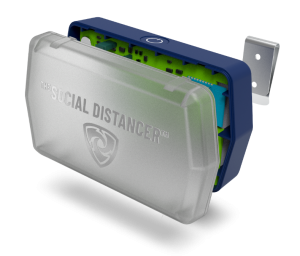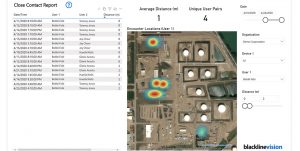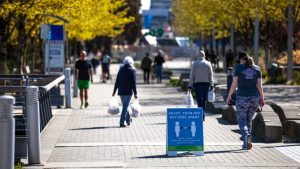New wearable tech devices and mobile gadgets are designed to ensure we observe the protocols of social distancing by measuring and tracking the distances between us.
Unlikely as it seems, some folks have difficulty counting to two these days. As in keeping a physical distance of two metres in mind when you interact with other people in a store, on the sidewalk, and when necessary, at work and at home.
With the pandemic lockdown measures loosening (or set to loosen) here and across North America, there will be an extra emphasis on the need to follow recommended physical distancing standards in certain specific physical environments, be they manufacturing plants, food processing centres, warehouses, office buildings or schools.
So it is not surprising at all to see increased efforts to bring to market some mobile or wearable product that gives the user a safe and easy way to keep two metres away from colleagues, co-workers or customers while remaining productive and focused on their work.

The Social Distancer has built-in sensors and other processors that measure and calculate the distance between employees. Image from Social Distancer Technologies Inc.
The new Social Distancer is one such product.
It’s a credit-card-sized device (thicker actually), with built-in sensors and other processors that measure and calculate the distance between employees. If employees are within 2.5 metres of one another, the device can flash red, vibrate and audibly alert them to move farther apart. The manufacturer describes how patent-pending technology in the device makes the social distancing distance calculation 10 times per second, providing a reliable reminder about physical distancing.
Working with support and development funding from the National Research Council of Canada Industrial Research Assistance Program, Social Distancer Technologies Inc. was formed by three manufacturing industry veterans from Quebec: Jarred Knecht of Promark Electronics, John Soares and Steve Zimmermann from CMP Advanced Mechanical Solutions.
“[M]ost workers have to interact collaboratively with one another at some point in their day, and it can be difficult to maintain physical distancing practices,” Jarred Knecht described in a release. “The Social Distancer was developed as an easy solution for workers to continue their projects while maintaining proper safety standards during COVID-19.”
The wearable device is priced starting at $199 CDN per unit; there’s a 10-pack starter kit (10 devices and 10 USB charging cables) for $1,990, available and shipping now to Canada, the United States, and Europe within four to six weeks. The company noted that a portion of the proceeds from every device sold will go to a COVID-19 relief fund in the country where the product is sold.
Estimote, a San Francisco-based location and proximity services provider, makes programmable Bluetooth-based beacons used in product- and now people-tracking.
Estimote’s programmable Bluetooth-based beacons are used in both product and now people tracking. Image from Estimote.
When the distance between two employees is too close, or when an employee enters an area that has been deemed off-limits due to COVID-19, the system (wearables include a wristwatch, pendant, or lanyard) beeps a warning.
Estimote is also developing mapping capabilities that can aggregate and display worker encounters as a heat map and the platform lets managers analyze tracked contacts, interactions, and duration over time.
Calgary, AB-based Blackline Safety Corp. has now launched a new contact tracing tool for industrial businesses that picks up where its smartphone-based solutions leave off.
(Long before the current coronavirus pandemic, as many as 15 per cent of the overall workforce in Canada, the U.S., and Europe were described as “lone workers”, people who work alone continuously or at various times throughout their workday. At the time, What’sYourTech.ca reported on various smartphone apps and digital platforms used to connect with workers, and privacy was of course described as an important factor in the worker safety equation. Today’s work-from-home world only increases the need for such connectivity and consideration.)

Contact tracing tools like those from Blackline Safety can be used to generate reports and maps of user activity and location history. Blackline Safety image.
Blackline’s connected safety wearables, smartphone app, location technology, cloud-hosted software, and data analytic tools offer a solution for enterprise-wide contact tracing that can geographically retrace a worker’s steps in the event of him or her presenting with symptoms or testing positive for the virus. They can help businesses identify locations where workers regularly come into close contact with each other or other Blackline tracking devices in a work environment. The company is also offering a webinar, e-Learning course and other resources to help businesses keep their workers safe during the pandemic.
“The COVID-19 outbreak only amplifies the need for connected safety technology at work,” said Sean Stinson, VP Sales and Product Management for Blackline. “Our new contact tracing tools will help businesses proactively monitor their social distancing performance and, should an employee contract COVID-19 or present with symptoms, …help them identify points of close employee contact inside their organization.”
Of course, any device that tracks a person’s whereabouts, personal contacts, work duties, or other activities can certainly raise privacy concerns.
They could also make an employee feel – and be – safer about at work, so a delicate balancing act is underway.
For now, any device that can eliminate awkward conversations or anxious discrepancies about just what two metres really means is more than welcome.
# # #

Pedestrians in a Vancouver park are reminded to stay two metres (six feet) away from each other to avoid coronavirus infection. That might be difficult in some situations and it might not be enough. Creative Commons image. GoToVan/Flickr (CC BY 2.0)
OK, so perhaps I am a bit harsh on folks who have difficulty counting to two.
It may well be we have to count higher.
Research underway at the University of Western Ontario for the past couple of years (before the novel coronavirus appeared) indicates that molecules expelled in a cough or sneeze can travel much further.
“There is no real logical reason for saying that two metres is somehow safe, but it’s much better than one metre or closer,” said Mechanical and Materials Engineering professor Eric Savory. “We’re not saying you’re going to get infected; we’re just saying there is a risk there. Obviously, it decreases the further you are away.”
While the study was conducted in a special cough chamber and not the great outdoors, underlying concerns are there no matter what the space.
“It’s pretty hard to avoid a cough,” Savory added. “By the time you react, it’s reached you. If you’re a couple of metres away from someone who coughs, then within about three seconds or so, their cough has reached you. Even when you’re two-and-a-half metres away, the airflow in the cough can still be moving at 200 mm a second.”
What’s more, according to findings recently reported in The Journal of the American Medical Association, droplets from a sneeze can travel up to eight metres!
Need an app to convert that to Imperial?
-30-



